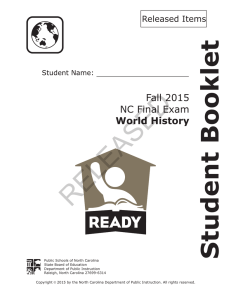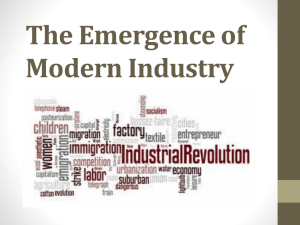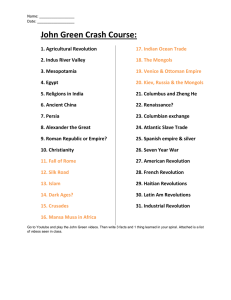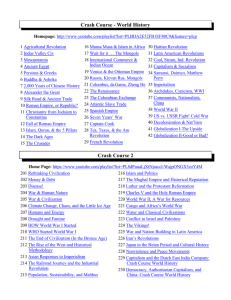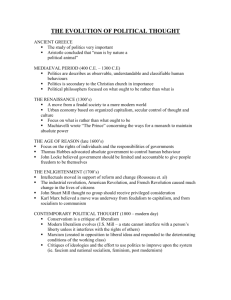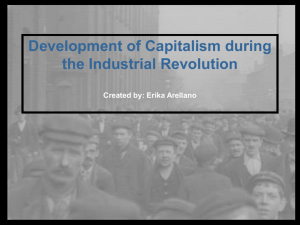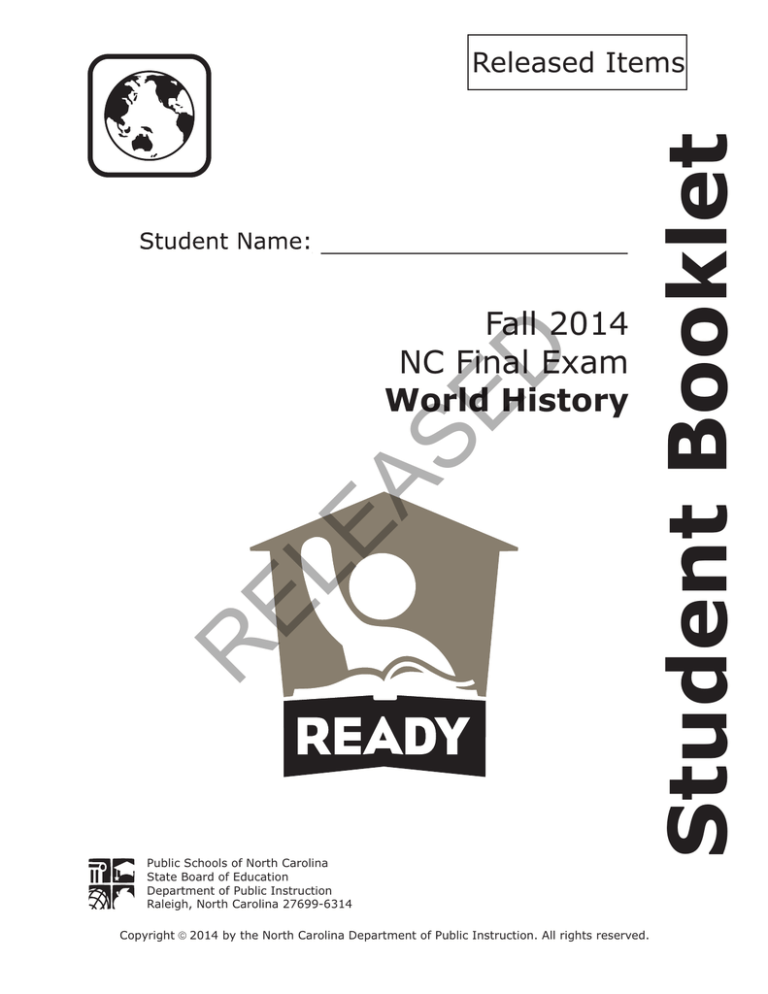
R
EL
EA
SE
D
Fall 2014
NC Final Exam
World History
Public Schools of North Carolina
State Board of Education
Department of Public Instruction
Raleigh, North Carolina 27699-6314
Copyright ã 2014 by the North Carolina Department of Public Instruction. All rights reserved.
Student Booklet
Released Items
WORLD HISTORY — RELEASED ITEMS
In the following excerpt, the Muslim scholar and traveler Ibn Battuta describes his
journey to Taghadda, a city of West Africa’s Songhai Empire:
D
I then set out in the direction of Taghadda by land with a large caravan of
merchants . . . I had a riding camel and a she-camel to carry my provisions.
We pushed on rapidly with our journey until we reached Taghadda . . . The
inhabitants of Taghadda have no occupation except trade. They travel [by
caravan] to Egypt every year, and import quantities of all the fine fabrics to
be had there and of other Egyptian [products]. . . . The copper mine is in the
outskirts of Taghadda . . . [the copper bars are] their medium of exchange; with
the thin bars they buy meat and firewood, and with the thick, slaves male and
female, millet, butter, and wheat.
SE
Excerpted from H. A. R. Gibb, translator, Ibn Battuta: Travels in Asia and Africa,
1325–1354 London: Routledge and Kegan Paul, 1929
What conclusion about trade in the Songhai Empire is supported by the excerpt?
Trade caravans allowed the Songhai Empire to exchange their valuable
metals for commodities and luxury items.
B
Trade caravans prevented the Songhai traders from selling their goods to
overseas customers.
C
Songhai traders welcomed travelers to their cities in hopes of selling them
fabrics and food items.
D
Songhai traders traveled to Egypt to seek ores and other valuable minerals
for building materials.
EL
EA
A
R
1.
1
Go to the next page.
WORLD HISTORY — RELEASED ITEMS
The following excerpt is from the Edict of Fontainebleau (1685 CE), which was
decreed by King Louis XIV of France:
We forbid our subjects of the R.P.R. [Protestantism] to meet any more for the
exercise of the said religion in any place or private house . . . We likewise forbid
all noblemen . . . to hold such religious exercises in their houses or fiefs, under
penalty . . . of imprisonment and confiscation. We enjoin all ministers of the said
R.P.R., who do not choose to become converts and to embrace the Catholic,
apostolic, and Roman religion, to leave our kingdom and the territories . . . within
a fortnight.
D
Internet History Sourcebooks Project. www.fordham.edu/halsall
What political conditions in France led to the Edict of Fontainebleau?
the parliament’s desire to exclude religious minorities from lawmaking
activities
B
the king’s absolute authority to make laws and dictate the state religion
C
the increase in quarreling among political factions of the landowning
aristocracy
D
the Catholic Church’s reputation for challenging political power in the
Holy Roman Empire
EL
EA
SE
A
R
2
2
Go to the next page.
WORLD HISTORY — RELEASED ITEMS
In the following excerpt, a Portuguese messenger addresses a local Hindu king of
southern India in 1509. The messenger asks for help in taking the Indian trading
port of Calicut from Ottoman and Arab control:
Frei Luis
SE
D
The King of Portugal commands me to render honour and willing service to all the
Gentile Kings of this land . . . they are to be well treated by me, neither am I to
take their ships nor their merchandise; but I am to destroy the Moors, with whom
I wage incessant war, as I know he also does . . . I am prepared and ready to
help him with the fleets and armies of the King . . . as often as he shall desire me
to do so; and I likewise, for my part, expect that he will help us with his army,
towns, harbours, and munitions, and with everything that I may require from his
kingdom; and the ships which navigate to his ports may pass safely throughout all
the Indian sea . . .
Which conclusion about the effects of increased trade is supported by the
above excerpt?
Overseas trade routes were too crowded and dangerous to produce
profitable returns.
B
Overseas trade routes encouraged cooperation between powerful empires
against small kingdoms and city-states.
C
Competition over Indian Ocean trade encouraged global empires to form
military alliances with local rulers.
D
Competition over Indian Ocean trade led to regional wars between European
navies and Indian city-states.
EL
EA
A
R
3
3
Go to the next page.
WORLD HISTORY — RELEASED ITEMS
In spite of the industrial and commercial prosperity that France momentarily
enjoys, the mass of the people, the twenty-five million peasants, suffer from a
great depression. The good harvests of the past few years have forced the prices
of corn much lower even than in England, and the position of the peasants under
such circumstances, in debt, sucked dry by usury and crushed by taxes, must be
anything but splendid. The history of the past three years has, however, provided
sufficient proof that this class of the population is absolutely incapable of any
revolutionary initiative. . . .
SE
D
Given this general prosperity, wherein the productive forces of bourgeois [middle
class] society are developing as luxuriantly as it is possible for them to do within
bourgeois relationships, a real revolution is out of the question. Such a revolution
is possible only in periods when both of these factors—the modern forces of
production and the bourgeois forms of production—come into opposition with each
other.
Karl Marx, 1850
Which statement best reflects Karl Marx′s argument, according to this excerpt?
The lower classes are prepared and motivated to revolt.
B
A nation can be poor and suffer economic depression.
C
Until the middle class is affected, reform is not likely.
D
High taxes lead to protests and civil unrest, then revolutions.
EL
EA
A
R
4
4
Go to the next page.
WORLD HISTORY — RELEASED ITEMS
The following excerpt is an Englishman’s firsthand account of the weeks leading up
to England’s Glorious Revolution (1688); in the Revolution, the Protestant ruler
William of Orange overthrew King James II, a Catholic.
. . . [King James II] called over 5,000 Irish, and 4,000 Scots, and continued to
remove Protestants and put in [Catholics] at Portsmouth and other places of trust,
and retained the Jesuits about him, increasing the universal discontent. It brought
people to so desperate a pass, that they seemed passionately to long for and
desire the landing of [William of Orange], whom they looked on to be their
deliverer from [Catholic] tyranny . . .
D
John Evelyn, diary entry, October 7, 1688
Internet History Sourcebooks Project, www.fordham.edu/halsall
SE
Using the above excerpt, what conclusion can be made about the Glorious
Revolution?
The revolution was furthered by English Protestants due to their distrust of
Catholic leaders.
B
The revolution was furthered by the English people due to the widespread
stories of William of Orange’s heroism.
C
The revolution was slowed by the English people due to their distrust of
foreigners.
D
The revolution was slowed by the English Protestants due to their
widespread admiration for King James’s religious tolerance.
EL
EA
A
R
5
5
Go to the next page.
WORLD HISTORY — RELEASED ITEMS
6
From 1803 to 1815, Britain and France were at war with each other. Wars can
bring economic opportunities, and American merchants hoped to sell goods to both
sides. Neither Britain nor France wanted American goods to reach its enemy, so
both sides imposed blockades and restrictions on neutral trade. Because Britain
had the larger navy, British restrictions were the most crippling to U.S. shipping.
British ships stopped American vessels, boarded them, seized contraband, and
impressed sailors. American objections were ignored, leading to a U.S. declaration
of war in 1812.
What conclusion can be drawn about the War of 1812?
B
To defeat France, Britain was willing to risk war with the United States.
C
British authorities felt threatened by the new U.S. Navy.
D
American citizens were indifferent toward the war.
EA
SE
D
France ended their alliance with the United States because of the delay in
their assistance.
EL
We, Wilhelm, by the grace of God King of Prussia, do herewith declare that we
have considered it a duty to our common fatherland to answer the summons of
the united German princes and cities and to accept the German imperial title. In
consequence, we and our successors on the throne of Prussia will henceforth bear
the imperial title in all our relations and in all the business of the German Empire,
and we hope to God that the German nation will be granted the ability to fashion a
propitious future for the fatherland under the symbol of its ancient glory.
R
7
A
Kaiser Wilhelm I, The Imperial Proclamation, January 1871
Internet History Sourcebooks Project, www.fordham.edu/halsall
What ideology is present in the proclamation of Wilhelm I?
A
socialism
B
militarism
C
nationalism
D
globalism
6
Go to the next page.
WORLD HISTORY — RELEASED ITEMS
[The rich] are led by an invisible hand to make nearly the same distribution of
the necessaries of life, which would have been made, had the earth been divided
into equal portions among all its inhabitants, and thus without intending it, without
knowing it, advance the interest of the society, and afford means to the
multiplication of the species.
Adam Smith, The Theory of Moral Sentiments, 1759
How does Smith’s idea of the “invisible hand” of capitalism compare to
modern-day government interventions such as the U.S.-led Marshall Plan or
the social-democratic governments of Western Europe?
Modern governments have modified capitalism to support other goals.
B
Modern governments have abandoned capitalism in favor of command
economies.
C
Modern governments have adopted capitalism without modification.
D
Modern governments have abandoned capitalism in favor of traditional
economies.
EL
EA
SE
D
A
R
8
7
Go to the next page.
WORLD HISTORY — RELEASED ITEMS
9
Capitalism — a social political-economic system characterized by individual or
corporate ownership of capital goods, by investments that are determined by
private decision, and by prices, production, and the distribution of goods that are
determined mainly by competition in a free market
Socialism — a political-economic system of social organization in which the
means of producing and distributing goods is owned collectively by the community
and is administered and distributed by a centralized government
Which statement differentiates capitalism from socialism?
B
Capitalist employment is directed by the government; socialist employment
is directed by individual initiative.
C
Capitalist pricing is based on competition; socialist prices are determined by
market forces.
D
Capitalism requires individualism and competition; socialism requires
governmental planning to distribute resources.
EA
SE
D
Capitalism requires redistributing resources from the rich to the poor;
socialism requires government distribution of resources.
EL
The Indian nationalist, Mahatma Gandhi, advocated the swadeshi movement
as a protest against British rule in India in the first half of the twentieth century.
The movement stressed the manufacture of Indian goods at home, especially
homespun cloth, as opposed to buying British manufactured goods.
Why did Indians decide to use this strategy?
R
10
A
A
to make it less profitable for the British to exploit India through colonial
trade
B
to prevent the British from establishing a monopoly in the cotton industry
C
to prepare for the British to abandon India as a colony
D
to limit British control of India’s domestic politics
8
Go to the next page.
WORLD HISTORY — RELEASED ITEMS
Over the past five years, a highly sophisticated team of operatives have stealthily
infiltrated more than 70 U.S. corporations and organizations to steal priceless
company secrets. They did it without ever setting foot in any victim’s office. . . .
This is the new face of corporate espionage. Thieves whose identities are safely
obscured by digital trade-craft rather than a ski mask, are robbing companies
of the ideas that are the source of American ingenuity. . . . Though this
new corporate espionage is rampant and rising, calculating the damage to
U.S. interests remains difficult. . . . In the aggregate, the theft of this property,
including everything from sensitive defense technology to innovative industrial
designs, insidiously erodes government and corporate competitive advantages
among global peers. . . . U.S. companies invest considerable time and money in
researching and developing new products, only to be undercut by competition,
using their stolen property to make cheaper versions. Unfortunately, companies
experience such losses every day . . . Yet many cyber-intrusions could be
prevented by implementing sound cyber-security practices.
SE
D
11
U.S. Commerce Secretary John Bryson, The New Face of Corporate Espionage,
March 9, 2012
EA
Using this information, what role does cyberespionage play in global trading?
Government monitoring agencies should commit military resources to
protecting commercial interests so that the world’s superpowers can
continue to thrive.
B
Individuals must assist companies in protecting their ideas so employment
will not decrease.
C
Cyber crimes are difficult to prove in any court of law, so government
officials have not committed sufficient resources to the matter.
D
Ideas fuel economic growth and competition, so there is an increased need
to protect electronically stored information on a worldwide scale.
R
EL
A
This is the end of the multiple-choice portion of the test.
9
Go to the next page.
WORLD HISTORY — RELEASED ITEMS
The question you read next will require you to answer in writing.
1. You may use the blank paper or your test book to plan your response
before you write your final answer on the answer sheet.
2. Only what is written on the lines of the answer sheet will be scored.
Read the text to respond to the item below.
EL
EA
SE
The Treaty of Versailles ended World War I and established the League of Nations.
The League of Nations had a mission to promote world peace and fight
human suffering around the world. In addition to creating the league, provisions
stripped away the power Germany had gained during the war. It required that the
German people pay an indemnity to the Allied powers of over $37 billion dollars to
compensate for damages from the war, and relinquish the territorial gains made in
World War I. Furthermore, it also severely restricted the size of the German army
and navy, and gave control of the Saarland—an important industrial region
in southwestern Germany—to France. When the Nazi party achieved power in
Germany, it worked to reverse the effects of the Treaty of Versailles and promised
revenge against the Allies for imposing it.
Evaluate the lasting impact of the Treaty of Versailles as a positive or negative
turning point in world history. Use one detail from the text above to support your
position.
R
12
D
3. Do not write beyond the end of the lines or in the margins.
10
Go to the next page.
WORLD HISTORY — RELEASED ITEMS
This is the end of the World History Released Items.
Directions:
1. Look back over your answers for the test questions.
2. Make sure all your answers are entered on the answer sheet. Only what is
entered on your answer sheet will be scored.
3. Put all of your papers inside your test book and close the test book.
D
4. Stay quietly in your seat until your teacher tells you that testing is
finished.
R
EL
EA
SE
5. Remember, teachers are not allowed to discuss items from the test with
you, and you are not allowed to discuss with others any of the test
questions or information contained within the test.
11
WORLD HISTORY — RELEASED ITEMS
Type2
Key
Percent Correct3
1
MC
A
49%
WH.2.7
2
MC
B
51%
WH.4.2
3
MC
C
48%
WH.4.4
4
MC
C
52%
WH.6.4
5
MC
A
44%
WH.6.2
6
MC
B
66%
WH.7.3
7
MC
C
62%
WH.7.2
8
MC
A
49%
WH.7.5
MC
D
67%
WH.7.5
MC
A
54%
WH.7.4
MC
D
49%
WH.8.4
CR
Rubric4
88%5
WH.7.1
11
12
EA
EL
10
R
9
SE
Item Number
D
World History
RELEASED Items1
Fall 2014
Answer Key
Standard
1
WORLD HISTORY — RELEASED ITEMS
1
These released items were administered to students during a previous test administration. This
sample set of released items may not reflect the breadth of the standards assessed and/or the
range of item difficulty found on the NC Final Exam. Additional items may be reviewed at
http://www.ncpublicschools.org/accountability/common-exams/released-forms/. Additional
information about the NC Final Exam is available in the Assessment Specification for each exam
located at http://www.ncpublicschools.org/accountability/common-exams/specifications/.
2
This NC Final Exam contains multiple-choice (MC) and short-answer constructed response (CR)
items.
3
Percent correct is the percentage of students who answered the item correctly during the
Spring 2014 administration.
4
D
Constructed response items are scored using a standard rubric. The following rubric was used
to score this item.
Score 0
Response fails to evaluate the lasting impact of the key turning point in world
history
Response fails to include one example of textual support OR includes one example
of textual support that is irrelevant because the response does not evaluate the
lasting impact of the key turning point in world history
EA
SE
Score 1
Response evaluates the lasting impact of the key turning point in world history
Response includes one example from the text that does not support the evaluation
OR lacks one example of textual support
Score 2
EL
Response evaluates the lasting impact of the key turning point in world history
Response includes one example of textual support that evaluates the lasting impact
of the key turning point in world history
R
5
Students will receive a score point of 0, 1, or 2 for this constructed response item. Percent
correct for this item is the percentage of students who scored a 1 or 2.
2
WORLD HISTORY — RELEASED ITEMS
Standard Descriptions
Only clarifying objective descriptions addressed by the released items in this booklet are listed
below. A complete list of the North Carolina Essential Standards for Science and Social Studies
may be reviewed at http://www.ncpublicschools.org/acre/standards/new-standards/.
WH.2.7
Analyze the relationship between trade routes and the development and decline of major
empires (e.g. Ghana, Mali, Songhai, Greece, Rome, China, Mughal, Mongol, Mesoamerica, Inca,
etc.).
D
WH.4.2
Explain the political, social and economic reasons for the rise of powerful centralized
nation-states and empires (e.g., Reformation, absolutism, limited monarchy, empires, etc.).
SE
WH.4.4
Analyze the effects of increased global trade on the interactions between nations in Europe,
Southwest Asia, the Americas and Africa (e.g., exploration, mercantilism, inflation, rise of
capitalism, etc.).
EA
WH.6.2
Analyze political revolutions in terms of their causes and impact on independence, governing
bodies and church-state relations. (e.g., Glorious Revolution, American Revolution, French
Revolution, Russian Revolution, Haitian, Mexican, Chinese, etc.).
EL
WH.6.4
Analyze the effects of industrialism and urbanization on social and economic reform
(e.g., Industrial Revolution, urbanization, growth of middle class, increase in productivity and
wealth, changes in economic status, new types of labor organizations, etc.).
R
WH.7.1
Evaluate key turning points of the modern era in terms of their lasting impact (e.g., conflicts,
documents, policies, movements, etc.).
WH.7.2
Analyze the increase in economic and military competition among nations in terms of the
influences of nationalism, imperialism, militarism, and industrialization (e.g., Ottoman Empire,
Japanese Empire, Prussian Empire, the German Empire, "Have and Have Nots" of Europe,
industrial America, etc.).
WH.7.3
Analyze economic and political rivalries, ethnic and regional conflicts, and nationalism and
imperialism as underlying causes of war (e.g., WWI, Russian Revolution, WWII).
3
WORLD HISTORY — RELEASED ITEMS
WH.7.4
Explain how social and economic conditions of colonial rule contributed to the rise of nationalistic
movements (e.g., India, Africa, Southeast Asia).
WH.7.5
Analyze the emergence of capitalism as a dominate economic pattern and the responses to it
from various nations and groups (e.g., utopianism, social democracy, socialism, communism,
etc.).
R
EL
EA
SE
D
WH.8.4
Analyze scientific, technological and medical innovations of postwar decades in terms of their
impact on systems of production, global trade and standards of living (e.g., satellites,
computers, social networks, information highway).
4


